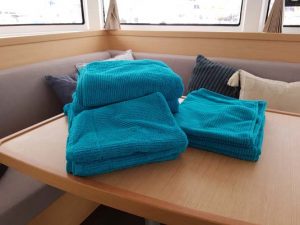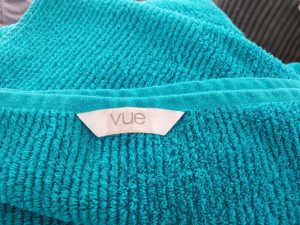At the outset we need to be clear that rigging issues and failures related to wear and tear are not included in the Lagoon or rigging manufacturer’s warranty. For our non-sailors and newbies to sailing rigging includes the mast stays and other supportive sail structures, halyards and sheets (ropes used to hoist and trim the sails). During the Pacific leg of our voyage we experienced critical rigging failures which had the potential to restrict or even halt our ability to travel under sail, that is without engine assistance. In this article we detail the rigging issues we encountered and how thinking outside the box, problem solving, and Peter’s amazing breadth of knowledge and skill helped us resolve these issues.
First up the shackle on the gooseneck fell off
FYI, the gooseneck is the point where the boom connects to the mast, and the shackle connects the gooseneck to the clew of the sail (the bottom corner of the sail nearest the boom and the mast). Bottom line, it’s important.
We were removing the first reef and hoisting the mainsail and couldn’t understand why we were struggling to get tension on the luff of the sail. (The luff is the edge of the sail nearest the mast). On closer inspection we found that the shank of the shackle was missing. (Try saying that quickly!) We have no idea when, why or where this occurred, the end result being that the mainsail could not be tensioned or set correctly and could not be used. A careful look around and would you believe we found the missing shank just lying on the ledge of the helm station. How it didn’t fall overboard is a mystery, but we were thankful that it didn’t. With the part in hand we were able to reconnect everything and Voila, the mainsail was once again up and doing its job.
Next the head car shank fell out
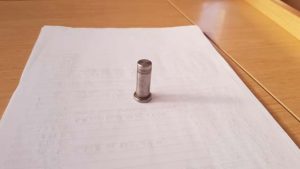 Approximately two weeks out from Panama City Peter was doing the routine morning check around the deck when he noticed a large stainless steel shank lying next to the gunwhale (a raised strip of fiberglass on the edge of the deck). This caused alarm bells to ring, as we had no idea where this shank had come from. We carefully checked all the standing rigging, then emailed Windcraft who replied that it probably wasn’t standing rigging. We continued to investigate with no luck, until we went to raise the mainsail and found that the shank belonged in the top head car on the mast. (This shank connects the head of the mainsail to the traveller cars which allow the mainsail to be lowered or raised). Fortunately, we were able to reinsert the shank and connect it to the mainsail and secure it with a spare split pin that Peter had brought as part of his repair kit.
Approximately two weeks out from Panama City Peter was doing the routine morning check around the deck when he noticed a large stainless steel shank lying next to the gunwhale (a raised strip of fiberglass on the edge of the deck). This caused alarm bells to ring, as we had no idea where this shank had come from. We carefully checked all the standing rigging, then emailed Windcraft who replied that it probably wasn’t standing rigging. We continued to investigate with no luck, until we went to raise the mainsail and found that the shank belonged in the top head car on the mast. (This shank connects the head of the mainsail to the traveller cars which allow the mainsail to be lowered or raised). Fortunately, we were able to reinsert the shank and connect it to the mainsail and secure it with a spare split pin that Peter had brought as part of his repair kit.
A takeaway message here for anyone planning a long passage is to have a really comprehensive repair, tool and spares kit on board.
Chafed reefing line
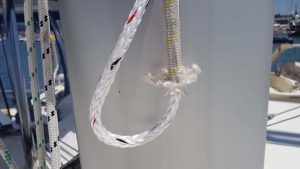 There are three reefing lines which can be used to reduce the amount of mainsail deployed. This is particularly important when sailing in stronger winds so that the catamaran is not overpowered.
There are three reefing lines which can be used to reduce the amount of mainsail deployed. This is particularly important when sailing in stronger winds so that the catamaran is not overpowered.
We discovered that the first reefing line had chafed quite badly where it entered the boom by the gooseneck. This appears to be a design fault as the reefing line comes down at an angle to the boom, the line then rubs against the edge of the boom when it is under tension creating a chafe point. (For the sailors – there is a sheave at the front of the boom that the reefing line runs through). We did not have a spare reefing line onboard, so Peter used a manual reef system whereby he physically tied the first reef points down onto the boom with spare line, and this worked well for the remainder of our journey across the Pacific.
Update: Since our return to Brisbane we have purchased a replacement reef line of slightly smaller diameter but much stronger (10mm Spectraspeed) along with two 60mm Seldon blocks which will provide a more direct route for the reefing line, and minimise the risk of chafe.
Main halyard and Code 0 halyard
At 0930 on Day 34 of our Pacific crossing and heading towards Tahiti, the main halyard suddenly and inexplicably snapped. This caused the boom to drop onto the bimini above the helm station and the mainsail quickly followed, flying down the mast. Luckily for us no damage was done to the bimini, boom or mainsail, however the halyard was another matter.
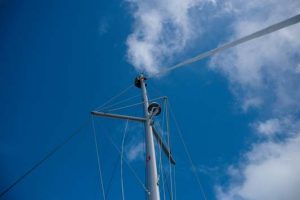 We secured the boom and the mainsail and continued our passage using the Code 0 only. Given our distance to Tahiti we decided to divert to the Apataki Atoll and attempt to repair the halyard. We arrived in the lee of this large beautiful atoll around 1700 hours and using the Code 0 halyard and Bosun’s chair, hoisted one of our crew (Patrick) to the top of the mast. Unfortunately, we could not retrieve the main halyard which had dropped down inside the mast, so we decided to use the topping lift as a substitute main halyard until we got to Tahiti. While at the top of the mast, Patrick also noticed that the Code 0 halyard was badly chafed and needed to be fixed sooner than soon. As another temporary fix, Patrick shortened the Code 0 halyard to remove tension from the frayed area. At 2030 hours with dusk approaching we left the atoll under full sail. Phew, another potential disaster averted we thought, but little did we know there was another challenge ahead.
We secured the boom and the mainsail and continued our passage using the Code 0 only. Given our distance to Tahiti we decided to divert to the Apataki Atoll and attempt to repair the halyard. We arrived in the lee of this large beautiful atoll around 1700 hours and using the Code 0 halyard and Bosun’s chair, hoisted one of our crew (Patrick) to the top of the mast. Unfortunately, we could not retrieve the main halyard which had dropped down inside the mast, so we decided to use the topping lift as a substitute main halyard until we got to Tahiti. While at the top of the mast, Patrick also noticed that the Code 0 halyard was badly chafed and needed to be fixed sooner than soon. As another temporary fix, Patrick shortened the Code 0 halyard to remove tension from the frayed area. At 2030 hours with dusk approaching we left the atoll under full sail. Phew, another potential disaster averted we thought, but little did we know there was another challenge ahead.
Peter was awoken by the on watch crew member in the early hours of the following morning. The topping lift (used as the substitute main halyard) had snapped, consequently the boom and mainsail had come crashing down on top of the bimini once again. We used a large fender to support the boom on top of the bimini, and secured the boom and the mainsail thus preventing any risk of damage to the bimini. To put this in perspective, we were still about four days out of Tahiti and continued sailing using the headsail and Code 0.
Both halyards were critical to optimal operations, it just wasn’t feasible to continue beyond Tahiti without having them repaired. With this in mind, and still a couple of days out from Tahiti, Peter emailed the Tahiti Crew via IridiumGo to arrange for a rigger to be available to fix and re-run the halyards while we were in Papeete. Unfortunately Tahiti isn’t awash with riggers and one of the most experienced riggers had hurt his back. Luckily for us his son Arturo, who is being trained by his dad, came to our rescue and under his dad’s supervision did an awesome job and we were good to go from a rigging perspective.
Jib halyard
The jib halyard provided by Lagoon is very poor quality, as it continually stretches and the luff of the jib becomes loose. Although not critical, more of an annoyance really, we can’t easily achieve the required tension in the sail. We persevered with the supplied halyard for the duration of the trip and plan to replace this with a better quality line in the near future.
Code 0 starboard block shackle
Another shackle issue! The shank of the shackle holding the Code 0 block had somehow worked itself loose and as a result the shackle had physically bent itself out of shape to the extent that the shank could not be screwed back in. Luckily Peter had a spare shackle in his kit bag, otherwise we would have been unable to use the Code 0 on port tack/reach for last leg of the trip.
Jib Roller Furler
On our way to Brisbane from Noumea, and during a morning deck check, Peter identified that the set screw on the jib roller furler, that holds the foil in place had come half way out. As a result the foil and the luff of the sail was loose, and this can impact on both the efficiency and effectiveness of the sail. It can also affect our ability to roll the sail in. To rectify this problem we sailed downwind, pulled the jib out tight and forced the foil back into the roller furler and then Peter was able to re-tighten the set screw. Once the set screw was tightened we resumed course and visually monitored the set screw for the remainder of the trip.
Rigging is such a critical element of sailing as it supports the sail structure, gives shape to each sail and allows the angle and amount of sail to be adjusted to wind conditions. On a sailing catamaran it is in constant use and is also exposed to the sea, salt, and weather elements particularly ultra violet light. And while we did not expect to experience these issues so early, Sea Goddess was only launched five months ago, we acknowledge that future issues are likely. However with regular checking and maintenance we hope to get a step ahead of any problems and address them in a proactive and timely way.
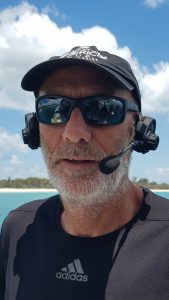
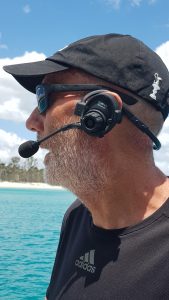

 Approximately two weeks out from Panama City Peter was doing the routine morning check around the deck when he noticed a large stainless steel shank lying next to the gunwhale (a raised strip of fiberglass on the edge of the deck). This caused alarm bells to ring, as we had no idea where this shank had come from. We carefully checked all the standing rigging, then emailed Windcraft who replied that it probably wasn’t standing rigging. We continued to investigate with no luck, until we went to raise the mainsail and found that the shank belonged in the top head car on the mast. (This shank connects the head of the mainsail to the traveller cars which allow the mainsail to be lowered or raised). Fortunately, we were able to reinsert the shank and connect it to the mainsail and secure it with a spare split pin that Peter had brought as part of his repair kit.
Approximately two weeks out from Panama City Peter was doing the routine morning check around the deck when he noticed a large stainless steel shank lying next to the gunwhale (a raised strip of fiberglass on the edge of the deck). This caused alarm bells to ring, as we had no idea where this shank had come from. We carefully checked all the standing rigging, then emailed Windcraft who replied that it probably wasn’t standing rigging. We continued to investigate with no luck, until we went to raise the mainsail and found that the shank belonged in the top head car on the mast. (This shank connects the head of the mainsail to the traveller cars which allow the mainsail to be lowered or raised). Fortunately, we were able to reinsert the shank and connect it to the mainsail and secure it with a spare split pin that Peter had brought as part of his repair kit. There are three reefing lines which can be used to reduce the amount of mainsail deployed. This is particularly important when sailing in stronger winds so that the catamaran is not overpowered.
There are three reefing lines which can be used to reduce the amount of mainsail deployed. This is particularly important when sailing in stronger winds so that the catamaran is not overpowered.  We secured the boom and the mainsail and continued our passage using the Code 0 only. Given our distance to Tahiti we decided to divert to the Apataki Atoll and attempt to repair the halyard. We arrived in the lee of this large beautiful atoll around 1700 hours and using the Code 0 halyard and Bosun’s chair, hoisted one of our crew (Patrick) to the top of the mast. Unfortunately, we could not retrieve the main halyard which had dropped down inside the mast, so we decided to use the topping lift as a substitute main halyard until we got to Tahiti. While at the top of the mast, Patrick also noticed that the Code 0 halyard was badly chafed and needed to be fixed sooner than soon. As another temporary fix, Patrick shortened the Code 0 halyard to remove tension from the frayed area. At 2030 hours with dusk approaching we left the atoll under full sail. Phew, another potential disaster averted we thought, but little did we know there was another challenge ahead.
We secured the boom and the mainsail and continued our passage using the Code 0 only. Given our distance to Tahiti we decided to divert to the Apataki Atoll and attempt to repair the halyard. We arrived in the lee of this large beautiful atoll around 1700 hours and using the Code 0 halyard and Bosun’s chair, hoisted one of our crew (Patrick) to the top of the mast. Unfortunately, we could not retrieve the main halyard which had dropped down inside the mast, so we decided to use the topping lift as a substitute main halyard until we got to Tahiti. While at the top of the mast, Patrick also noticed that the Code 0 halyard was badly chafed and needed to be fixed sooner than soon. As another temporary fix, Patrick shortened the Code 0 halyard to remove tension from the frayed area. At 2030 hours with dusk approaching we left the atoll under full sail. Phew, another potential disaster averted we thought, but little did we know there was another challenge ahead.